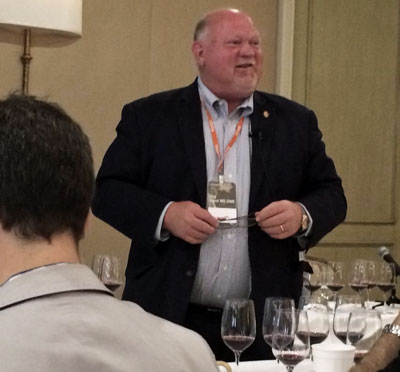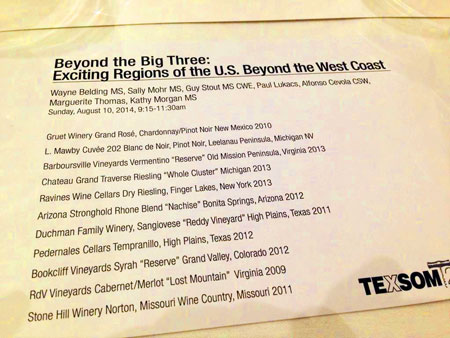Texsom 2014: Sommeliers Get Beyond the Big Three
The @ItalianWineGuy, Alfonso Cevola moderated an interesting tasting panel this morning at Texsom 2014. It had to be one of the most diverse sessions by far at this years conference. It included bubbles from New Mexico, a bracing cuvée from Michigan, counter currents of Michigan and New York Rieslings, Mediterranean-heritaged red wines (Sangiovese and Tempranillo) from Texas, and a (non-vinifera) Norton from America’s heartland, Missouri.
Cevola reminded the participants in his tasting session, “It was only 30 years ago when the “Big Three” of American wine (California, Washington and Oregon) were a new phenomenon, just like the “Beyond the Big Three” wines are today.”
At one point, we were only a few words short of a major encounter between Paul Lukacs and Guy Stout MS when Paul said that the best domestic Viognier he’s found is from Virginia. Guy bristled and retorted that Texas has some pretty darn good Viognier juice, too.
No matter if we couldn’t agree which state brought the best wine to this tasting, there appeared to be universal agreement on the fact that these local wines were on the cutting edge of diversity. Cevola said, “These wines could infuse an interesting new diversity to wine lists.”
Cevola’s reference was aimed directly at restaurant wine lists that are far too long on the same group of Chardonnays and Cabernets (five of which taste pretty much the same). In contrast, local wines from around the United States have interesting nuances that offer new experiences for wine drinkers. All of the panelists agreed that it’s high time that sommeliers realize that local wines can bring an exciting new element to their wine lists.

After his first hand account of his battle with the Raccoons in his Texas hill country vineyard, Guy Stout MS, presented two Texas wines. The first was Duchman Family Winery Sangiovese (single vineyard designated from Reddy Vineyards), Texas High Plains AVA. The second was Pedernales Cellars Tempranillo, Texas High Plains. Neither was heavily extracted or high in alcohol, but brought a minerally character that shined through the tart berry character of the wines. These are the terrior-driven wines that are now the calling card for Texas that will remain in future years.
I think that panelist, Wayne Bending MW summed it up best when he said, “Rather than trying to find obscure wine regions in Eastern Europe, restaurant sommeliers would be better served to look to obscure region right here in America. They have a lot to offer.”

